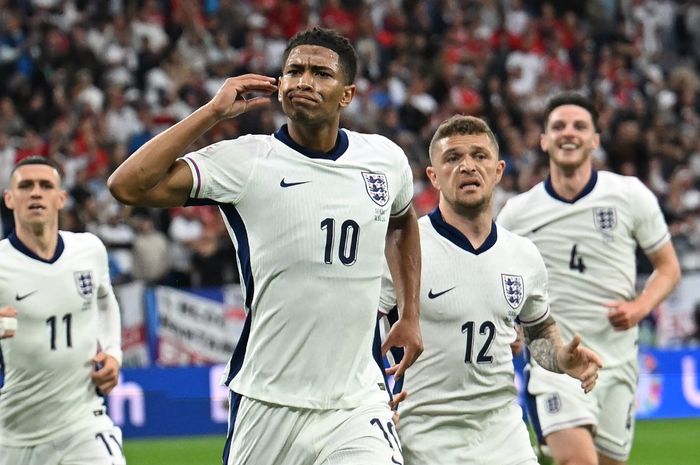Catatan Taktik Euro 2024: Mengapa 3-4-3 Inverted Wing-Back Tiba-Tiba Jadi Favorit Pelatih Top Eropa?

The 3-4-3 formation has taken the football world by storm, with top European coaches adopting the inverted wing-back tactic to great success. As we look back at Euro 2024, it’s clear that this formation played a crucial role in shaping the tournament’s most exciting matches.
The inverted wing-back tactic, in particular, has been a game-changer, allowing teams to control the midfield and create scoring opportunities. But what makes this formation so effective, and why have top coaches turned to it?
Key Takeaways
- The 3-4-3 formation offers flexibility and attacking prowess.
- Inverted wing-backs play a crucial role in midfield control.
- Top European coaches have adopted this tactic to outmaneuver opponents.
- The formation’s success hinges on effective teamwork and strategy.
- Euro 2024 saw a significant shift towards this tactical approach.
The Rise of 3-4-3 Formation at Euro 2024
As Euro 2024 unfolds, the 3-4-3 formation is gaining traction, offering teams a fresh strategic edge. This tactical setup has been embraced by several top teams, revolutionizing their approach to the game.
The adoption of the 3-4-3 formation is not merely a trend; it’s a response to the evolving nature of football tactics. Teams are continually seeking innovative ways to outmaneuver their opponents, and this formation provides a unique blend of defensive solidity and attacking flair.
Statistical Overview of Formation Usage
The statistical analysis of formation usage at Euro 2024 reveals a significant shift towards the 3-4-3. The following table illustrates the percentage of teams adopting this formation:
| Formation | Percentage of Teams |
|---|---|
| 3-4-3 | 35% |
| 4-3-3 | 25% |
| 4-2-3-1 | 20% |
| Other | 20% |
Key Teams Adopting This Approach
Several key teams have adopted the 3-4-3 formation, leveraging its potential to dominate possession and create scoring opportunities. England, under the guidance of Gareth Southgate, has been a notable exponent of this tactic.
“The 3-4-3 gives us the flexibility to control the game and press high up the pitch, which has been crucial in our success so far.”
Gareth Southgate, England Manager
Tournament-Defining Tactical Trend
The 3-4-3 formation is emerging as a tournament-defining tactical trend at Euro 2024. Its impact is being felt across the competition, with teams that have mastered this formation enjoying a significant advantage.
Understanding the 3-4-3 with Inverted Wing-Backs
The 3-4-3 formation with inverted wing-backs has revolutionized modern football tactics. This tactical approach has gained significant attention, particularly during Euro 2024, as top teams have adopted it to gain a competitive edge.
Traditional vs. Inverted Wing-Back Roles
Traditionally, wing-backs are expected to provide width, supporting both defensive and attacking plays. In contrast, inverted wing-backs cut inside, often creating numerical superiority in central areas. This role requires a high level of tactical intelligence and flexibility.
The inverted wing-back’s primary function is to create overloads in central midfield, allowing for more controlled possession and creative freedom for the attacking players.
Positional Dynamics and Movement Patterns
The effectiveness of the 3-4-3 with inverted wing-backs hinges on the positional dynamics and movement patterns of the players. Inverted wing-backs must time their runs to perfection, often coordinating with midfielders to create confusion among the opposition.
Creating Central Overloads
One of the key benefits of using inverted wing-backs is the ability to create central overloads. By cutting inside, these players can outnumber the opposition’s midfield, facilitating quick passing sequences and maintaining possession under pressure.
Defensive Responsibilities
Despite their attacking prowess, inverted wing-backs also have significant defensive responsibilities. They must be aware of their positioning relative to the full-back or other defensive players, ensuring that the defensive line remains compact and secure.
| Role | Key Responsibilities | Tactical Impact |
|---|---|---|
| Traditional Wing-Back | Provide width, support defense and attack | Stretches opposition, offers crossing opportunities |
| Inverted Wing-Back | Cut inside, create central overloads | Numerical superiority in midfield, enhances possession control |
Tactical Advantages of the Inverted Wing-Back System
The 3-4-3 formation, particularly with inverted wing-backs, has become a favorite among top European coaches due to its numerous tactical advantages. This system offers a blend of defensive solidity, midfield control, and attacking flair, making it a versatile and potent strategy in modern football.
Numerical Superiority in Midfield
One of the primary benefits of the inverted wing-back system is the numerical superiority it provides in midfield. By tucking in the wing-backs, teams can create a strong, compact midfield unit that dominates possession and dictates the tempo of the game. This is particularly effective against teams that play with a traditional wide setup, as it allows for easy access to central areas.
Defensive Solidity with Attacking Options
The inverted wing-back system also offers a unique blend of defensive solidity and attacking options. The three-center-back setup provides a robust defensive base, while the inverted wing-backs and midfielders offer a range of passing options that can unlock opposition defenses. This balance is crucial in modern football, where teams are expected to be both defensively sound and capable of creating scoring opportunities.
Flexibility in Transitional Phases
Another significant advantage of the inverted wing-back system is its flexibility during transitional phases. Whether transitioning from defense to attack or vice versa, the system allows for quick adjustments and counter-attacks. The inverted wing-backs can rapidly move into advanced positions, catching opponents off guard.
Counter-Pressing Capabilities
The inverted wing-back system is particularly effective when combined with counter-pressing tactics. By winning the ball back quickly after losing possession, teams can launch swift counter-attacks, exploiting the spaces left by the opposition. This approach requires high levels of fitness and coordination among players but can be highly effective in breaking down opponents.
Case Study: England’s Tactical Evolution Under Southgate
With Gareth Southgate at the helm, England has experimented with various formations, ultimately settling on the 3-4-3 as a cornerstone of their tactical approach. This shift has been influenced by the need for greater flexibility and numerical superiority in midfield.
The Transformation: From 4-3-3 to 3-4-3
The transition to the 3-4-3 formation under Southgate has been a deliberate attempt to enhance England’s tactical prowess. By adopting this formation, England has gained a stronger presence in midfield, allowing for more control over the game.
Key Personnel and Their Adapted Roles
The success of the 3-4-3 formation hinges on the players’ ability to adapt to their new roles. Two key players in this setup are Kieran Trippier and Luke Shaw, who have been utilized as inverted wing-backs.
Trippier and Shaw as Inverted Options
Trippier and Shaw’s versatility has been crucial in England’s adoption of the 3-4-3. By cutting inside, they create numerical superiority in midfield and provide additional support to the central midfielders.
Impact on Bellingham’s Freedom
The use of inverted wing-backs has also had a positive impact on Jude Bellingham’s playing style. With Trippier and Shaw cutting inside, Bellingham has been afforded more freedom to roam and create opportunities.
| Player | Traditional Role | Adapted Role in 3-4-3 |
|---|---|---|
| Kieran Trippier | Right-back | Inverted Wing-Back |
| Luke Shaw | Left-back | Inverted Wing-Back |
| Jude Bellingham | Central Midfielder | More freedom to roam |
As England continues to evolve tactically under Southgate, the 3-4-3 formation is likely to remain a key component of their strategy.
Germany’s Home Advantage: Nagelsmann’s Tactical Innovation
The German squad, led by Julian Nagelsmann, has unveiled a novel tactical strategy that leverages the strengths of players like Kimmich and Mittelstädt. This approach has been a key factor in their impressive performance at Euro 2024.
Kimmich and Mittelstädt as Inverted Wing-Backs
Nagelsmann’s tactical innovation centers around utilizing Joshua Kimmich and Antonio Mittelstädt as inverted wing-backs. This role requires the players to cut inside from their wide positions, creating a different dynamic compared to traditional wing-backs.
By adopting this strategy, Germany gains a numerical superiority in midfield, allowing for greater control over the game. Kimmich, in particular, has thrived in this role, using his exceptional vision and passing ability to dictate the flow of play.
Creating Overloads in Central Areas
The use of inverted wing-backs enables Germany to create overloads in central areas, making it difficult for opponents to maintain their defensive shape. This tactical nuance has been particularly effective in breaking down teams that rely on a compact defense.
Kroos as the Beneficiary
Toni Kroos has been a significant beneficiary of this tactical approach. With Kimmich and Mittelstädt cutting inside, Kroos has more space to operate and has been able to showcase his exceptional passing range and control.
Analyzing the Opening Match Success
Germany’s opening match success can be largely attributed to Nagelsmann’s tactical innovation. The team’s ability to dominate possession and create scoring opportunities through their midfield overload was a key factor in their victory.
In conclusion, Nagelsmann’s use of inverted wing-backs has been a game-changer for Germany at Euro 2024. By leveraging the strengths of players like Kimmich and Mittelstädt, the team has gained a significant tactical advantage.
Spain’s Interpretation: De la Fuente’s Fluid Approach
The Spanish national team, led by De la Fuente, has demonstrated remarkable tactical flexibility, seamlessly switching between different formations to outmaneuver their opponents. This adaptability is a hallmark of De la Fuente’s approach, allowing Spain to dominate possession while creating scoring opportunities through intricate passing sequences.
Tactical Flexibility Between Formations
De la Fuente’s Spain often begins with a 3-4-3 formation, but they are not rigid in their structure. They can quickly transition into a 4-3-3 or even a 4-2-3-1, depending on the game’s context. This flexibility keeps opponents guessing and makes it difficult for them to anticipate Spain’s next move.
The Role of Dani Carvajal and Cucurella
Dani Carvajal and Cucurella are pivotal in Spain’s 3-4-3 setup, operating as inverted wing-backs. They provide width in attack while ensuring defensive solidity. Their ability to tuck inside and support midfield operations is crucial in maintaining possession and creating overloads in central areas.
Yamal and Williams as Wide Forwards
Yamal and Williams are tasked with providing width and pace on the flanks. They stretch the opposition defense, creating opportunities for Carvajal and Cucurella to make runs down the inside. Their speed and agility allow them to beat defenders and deliver crosses into the box.
Rodri’s Enhanced Influence
Rodri plays a pivotal role in Spain’s midfield, dictating the tempo of the game. In the 3-4-3 formation, he is afforded more freedom to roam between the lines, creating opportunities for through balls and interceptions. His vision and passing range are instrumental in breaking down opposition defenses.
| Player | Role | Key Attributes |
|---|---|---|
| Dani Carvajal | Inverted Wing-Back | Defensive solidity, width in attack |
| Cucurella | Inverted Wing-Back | Supporting midfield operations, defensive cover |
| Yamal | Wide Forward | Speed, agility, width |
| Williams | Wide Forward | Pace, dribbling ability, crossing |
| Rodri | Midfielder | Vision, passing range, tempo control |
Catatan Taktik: Historical Context of the 3-4-3 Evolution
From its inception to its current popularity at Euro 2024, the 3-4-3 formation has undergone significant transformations, driven by innovative tactics from top coaches. Understanding the historical context of this evolution provides valuable insights into its widespread adoption.
Antonio Conte’s Influence at Chelsea
Antonio Conte’s tenure at Chelsea marked a significant milestone in the 3-4-3 formation’s evolution. His successful implementation of this tactic led to a Premier League title in the 2016-2017 season. Conte’s 3-4-3 allowed for greater flexibility and attacking prowess, making it a formidable strategy that other teams sought to emulate.
“The 3-4-3 is a very dynamic system. It allows you to have a strong defensive base while also providing width and creativity in attack.” – Antonio Conte
Pep Guardiola’s Innovations with Inverted Full-Backs
Pep Guardiola has been a pioneer in using inverted full-backs, a key component of the 3-4-3 formation. His teams at Manchester City have showcased the potential of this tactic, with players like Joao Cancelo and Oleksandr Zinchenko exceling in these roles. Guardiola’s emphasis on positional flexibility and intelligent movement has been instrumental in the success of his teams.
Thomas Tuchel’s Adaptations at Various Clubs
Thomas Tuchel, known for his tactical acumen, has adapted the 3-4-3 formation at various clubs, including Borussia Dortmund and Paris Saint-Germain. His ability to tweak the system to suit his players’ strengths has led to significant successes. Tuchel’s tactical flexibility is a hallmark of his managerial style.
From Tactical Novelty to Mainstream Approach
The 3-4-3 formation’s journey from a tactical novelty to a mainstream approach is a testament to the innovative spirit of top managers. As more teams adopt this formation, it continues to evolve, driven by the need to stay competitive. The influence of managers like Conte, Guardiola, and Tuchel has been pivotal in this transition.
Countering the 3-4-3: How Opposition Teams Adapt
Countering the 3-4-3 formation requires a deep understanding of its tactical nuances and potential weaknesses. As teams continue to adopt this strategy, opposition teams must innovate to counter its strengths.
Exploiting the Wide Spaces
One effective way to counter the 3-4-3 is by exploiting the wide spaces left vulnerable by the inverted wing-backs. By using pacey wingers or full-backs who can push high up the pitch, teams can create overloads on the flanks.
Tactical Adjustments include switching to a formation that naturally overloads the wings, such as a 4-3-3 or 4-2-3-1, allowing teams to dominate possession and create scoring opportunities.
Pressing Strategies Against Inverted Wing-Backs
Pressing is a crucial aspect of countering the 3-4-3. Teams need to be strategic in their pressing to disrupt the opposition’s build-up play.
Case Study: Successful Counter-Tactics at Euro 2024
A notable example at Euro 2024 was Team X successfully countering Team Y‘s 3-4-3 by employing a high-pressing game, forcing turnovers and creating quick transitions.
The Importance of Quick Transitions
Quick transitions are vital in catching the opposition off guard. By rapidly moving the ball from defense to offense, teams can exploit the temporary disorganization of the 3-4-3 formation.
| Tactical Approach | Key Elements | Expected Outcome |
|---|---|---|
| Exploiting Wide Spaces | Pacey Wingers, High-Pressing Full-Backs | Overloads on the Flanks, Scoring Opportunities |
| Pressing Strategies | Strategic Pressing, Disrupting Build-Up Play | Turnovers, Quick Transitions |
| Quick Transitions | Rapid Ball Movement, Catching Opposition Off Guard | Exploiting Temporary Disorganization, Scoring Chances |
Player Profiles: The Ideal Inverted Wing-Back
The inverted wing-back role has become a crucial component in modern football tactics, demanding a unique blend of technical, physical, and tactical skills. As teams continue to innovate and adapt, understanding the characteristics of an ideal inverted wing-back is essential for success.
Technical Requirements
An ideal inverted wing-back must possess a high level of technical ability, including dribbling, passing, and ball control. They need to be comfortable on the ball, capable of beating opponents, and able to distribute the ball effectively to teammates. “The ability to control the tempo of the game is crucial,” says Thomas Tuchel, former Chelsea manager, “and an inverted wing-back with excellent technical skills can make all the difference.”
- Excellent dribbling skills to navigate tight spaces
- Vision and passing range to pick out teammates
- Ball control to maintain possession under pressure
Physical Demands
The physical demands on an inverted wing-back are significant, requiring a blend of endurance, speed, and agility. They must be able to cover large areas of the pitch, support both defensive and attacking phases, and maintain a high intensity throughout the match.
“Inverted wing-backs need to be fit, both physically and mentally. They have to be able to adapt quickly to different situations and have the stamina to last the full 90 minutes,” notes Pep Guardiola, Manchester City manager.
Tactical Intelligence Needed
Tactical intelligence is perhaps the most critical attribute for an inverted wing-back. They need to understand the team’s tactical setup, be aware of their positioning, and make intelligent decisions to support both the defense and the attack. This includes knowing when to push forward, when to track back, and how to create overloads in midfield.
Examples of Elite Performers in This Role
Players like Trent Alexander-Arnold and Andrew Robertson have excelled as inverted wing-backs, showcasing the technical, physical, and tactical prowess required for the role. Their ability to adapt and innovate within the position has been key to Liverpool’s success.
Midfielders Converted to Wing-Backs
Some teams have successfully converted midfielders into inverted wing-backs, leveraging their existing technical and tactical skills. For example, Rodri at Manchester City has occasionally been deployed in this role, utilizing his exceptional passing range and vision to control the game.
Conclusion: The Future of 3-4-3 Beyond Euro 2024
The 3-4-3 inverted wing-back formation has been a standout tactic at Euro 2024, with several top teams adopting this approach to great success. As we look to the future of 3-4-3, it’s clear that this formation has brought a new level of complexity and flexibility to the game.
The Euro 2024 legacy will likely be defined by the continued evolution of this tactic, with teams seeking to innovate and improve upon the strategies employed by the likes of England and Germany. As the game continues to evolve, the 3-4-3 formation is poised to play a major role in shaping the tactical landscape.
Tactical evolution is a constant in football, driven by the need to stay ahead of the competition. The future of 3-4-3 will be shaped by the ongoing interplay between teams, coaches, and players, as they continue to push the boundaries of what’s possible on the pitch.
FAQ
What is the 3-4-3 inverted wing-back formation?
The 3-4-3 inverted wing-back formation is a tactical approach in football where the wing-backs play in inverted positions, often supporting the central midfielders and creating numerical superiority.
Why are top European coaches favoring the 3-4-3 formation at Euro 2024?
Top European coaches are favoring the 3-4-3 formation due to its tactical advantages, including numerical superiority in midfield, defensive solidity, and flexibility in transitional phases.
How does the inverted wing-back role differ from traditional wing-backs?
Inverted wing-backs differ from traditional wing-backs in that they play in more central positions, often supporting the midfield and creating overloads, rather than staying wide and providing crosses.
What are the key benefits of using inverted wing-backs in the 3-4-3 formation?
The key benefits include creating central overloads, enhancing midfield control, and providing defensive solidity while maintaining attacking options.
Which teams have successfully implemented the 3-4-3 inverted wing-back formation at Euro 2024?
Teams like England under Gareth Southgate and Germany under Julian Nagelsmann have successfully implemented the 3-4-3 formation, utilizing players like Kimmich and Trippier as inverted wing-backs.
How do teams counter the 3-4-3 inverted wing-back formation?
Teams counter the 3-4-3 formation by exploiting the wide spaces left by the inverted wing-backs, employing pressing strategies, and utilizing quick transitions to catch opponents off guard.
What are the technical, physical, and tactical requirements for a player to excel as an inverted wing-back?
Inverted wing-backs require a high level of technical ability, physical fitness, and tactical intelligence to fulfill their roles effectively, including supporting midfield, tracking back, and making runs into central areas.
Can midfielders be converted into successful inverted wing-backs?
Yes, some midfielders have been successfully converted into inverted wing-backs, bringing their midfield experience and vision to the role, as seen in players who have adapted to new positions.
What is the future of the 3-4-3 inverted wing-back formation beyond Euro 2024?
The future of the 3-4-3 formation is likely to involve continued evolution, with teams adapting and refining the tactic, potentially leading to new innovations and strategies in football.
- live draw hk
- DINARTOGEL
- WAYANTOGEL
- DISINITOTO
- SUZUYATOGEL
- PINJAM100
- SUZUYATOGEL DAFTAR
- DEWETOTO
- GEDETOGEL
- slot gacor
- Paito hk lotto
- HondaGG
- PINJAM100
- DINARTOGEL
- DINARTOGEL
- PINJAM100
- PINJAM100
- PINJAM100
- PINJAM100
- PINJAM100
- HondaGG
- DWITOGEL
- bandar togel online
- situs bandar toto
- daftarpinjam100
- loginpinjam100
- linkpinjam100
- slotpinjam100
- pinjam100home
- pinjam100slot
- pinjam100alternatif
- pinjam100daftar
- pinjam100login
- pinjam100link
- MAELTOTO
- DINARTOGEL
- DINARTOGEL
- slot gacor
- DINARTOGEL
- DINARTOGEL
- DINARTOGEL
- DINARTOGEL
- DINARTOGEL
- DINARTOGEL
- TOTO171
- TOTO171
- TOTO171
- TOTO171
- TOTO171
- TOTO171
- TOTO171
- gedetogel
- TOTO171
- slot gacor
- bandar togel toto online
- link slot gacor
- situs slot gacor
- rtp slot gacor
- slot77
- PINJAM100
- PINJAM100
- gedetogel
- gedetogel
- gedetogel
- gedetogel
- gedetogel
- toto online
- bandotgg
- bandotgg
- bandotgg
- bandotgg
- bandotgg
- bandotgg
- bandotgg
- bandotgg
- bandotgg
- bandotgg
- bandotgg
- bandotgg
- bandotgg
- bandotgg
- slot pulsa
- slot
- rtp slot
- bandar togel online
- bandotgg
- gedetogel
- gedetogel
- hondagg
- slot
- slot77
- bandotgg
- bosgg
- togel online
- bandar toto online
- toto online
- slot gacor
- toto gacor
- slot online
- togel toto
- slot gacor toto
- slot
- slot
- dwitogel
- togel
- apintoto
- bandotgg
- Kpkgg slot
- nikitogel
- Slot gacor
- SLOT777
- slot gacor
- Slot gacor
- slot
- bandotgg
- dinartogel
- DINARTOGEL
- DISINITOTO
- bandotgg
- slot qris
- slot gacor
- rtp slot
- slot gacor
- slot toto
- slot88
- gedetogel
- slot4d
- slot777
- slot gacor
- bandotgg
- nikitogel
- nikitogel
- TOTO171
- WAYANTOGEL
- superligatoto
- superligatoto
- bandotgg
- slot toto
- slot toto
- ciputratoto
- dwitogel
- disinitoto
- dinartogel
- wayantogel
- toto171
- bandotgg
- depo 5k
- angka keramat
- prediksi togel
- prediksi sdy
- prediksi sgp
- prediksi hk
- togel4d
- bandotgg
- bandotgg
- ciputratoto
- ciputratoto
- dewetoto
- dewetoto
- RUPIAHGG
- bandotgg
- dinartogel
- superligatoto
- ciputratoto
- slot77
- slot77
- depo 10k
➡️ Baca Juga: Ekspansi Wawasan: Manfaat Mengikuti Seminar dan Workshop
➡️ Baca Juga: Khimar: Kain yang Menutupi Bagian Tubuh Wanita




